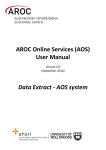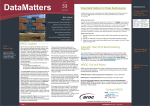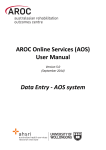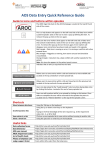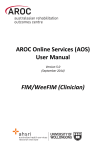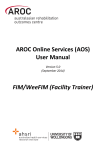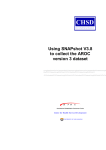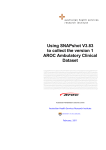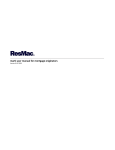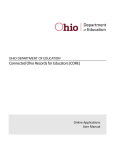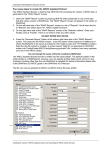Download AOS User Manual - Data Upload
Transcript
AROC Online Services (AOS) User Manual Version 5.0 (September 2014) Data Upload - AOS system Contents Introduction ..................................................................................................................................................... 2 Flow chart of AOS functionality .......................................................................................................................... 2 Computing requirements.................................................................................................................................... 2 Session time-out ................................................................................................................................................. 3 Getting started with AOS.................................................................................................................................... 3 Getting a FIM ID ............................................................................................................................................. 3 Getting an AOS login...................................................................................................................................... 3 Logging into AOS............................................................................................................................................ 5 Contacting AROC ................................................................................................................................................ 5 If you have an AOS username........................................................................................................................ 5 If you have a FIM ID ....................................................................................................................................... 5 If you do not have an AOS username of FIM ID ............................................................................................ 6 The AOS homepage .......................................................................................................................................... 7 Returning to the AOS home page .................................................................................................................. 7 My Details .......................................................................................................................................................... 7 Checking my FIM/WeeFIM status ................................................................................................................. 8 Changing my password .................................................................................................................................. 8 My Facility .......................................................................................................................................................... 8 Getting help in AOS ............................................................................................................................................ 8 Lodging a support ticket ................................................................................................................................ 9 Logging out of AOS ........................................................................................................................................... 10 Uploading data in AOS ................................................................................................................................... 11 Flow for uploading data to the AROC database ............................................................................................... 11 Accessing the Online Data Upload System (AOS-ODUS) .................................................................................. 13 Selecting one facility or one ward to upload data to .................................................................................. 13 Selecting more than one facility to upload data to ..................................................................................... 13 Uploading an AROC data extract file................................................................................................................ 14 Performing a Conflict Review ........................................................................................................................... 16 Reviewing the Upload Data Audit .................................................................................................................... 17 Accepting the uploaded data into the AROC database .................................................................................... 19 Handling a pending upload .............................................................................................................................. 19 Discarding an upload file .................................................................................................................................. 20 Deleting an upload file AFTER it has been added to the AROC database.................................................... 20 Data Audits in AOS ......................................................................................................................................... 21 Correcting errors identified by the Facility Data Audit ..................................................................................... 21 Facilities using the AOS Online Data Entry System ...................................................................................... 21 Facilities using AOS Online Data Upload System ......................................................................................... 22 Draft AOS User Manual (V4.5 June 2014) 1 Introduction AROC Online Services (AOS) is a secure, web-based service that enables staff of AROC member facilities to manage their facility’s AROC data, their personal details and FIM/WeeFIM credentialing status. AOS is intended for: • Staff involved in the data entry or data upload of AROC data • Staff responsible for downloading and reviewing AROC benchmarking reports • Staff wanting to extract and analyse their facility’s data • Staff needing to become credentialed/re-credentialed in FIM/WeeFIM • Staff planning on sitting the online FIM/WeeFIM refresher course • Staff intending on purchasing/managing FIM/WeeFIM keys and resources. Facilities can opt to have one or many of their staff registered to use AOS and are responsible for ensuring that no unauthorised staff gains access to AOS. This user manual provides AROC members with detailed instructions on how to use the functions available within AOS. Flow chart of AOS functionality The flow chart presented in Figure 1 provides a quick reference to all the functions available from the AOS menu and demonstrates the pathways of entry into the system: A) AOS Login B) FIM ID Each function listed in the flow chart is explained in detail within this document. This manual is available online at from both the AROC Homepage (AROC Online Services … AOS and FIM User Manuals) and from all AOS Menus (Help … User Manual) and can be downloaded as a complete document or by chapter. Computing requirements To access AOS users will need: • An AOS username and password or FIM ID (page 3) • Internet connectivity • A standard internet browser with pop-ups, browser scripting and cookies enabled • Adobe Acrobat reader to view or open PDF files. The recommended browsers are: • Internet Explorer 8.0+ • Mozilla Firefox • Google Chrome • Safari The recommended screen resolution is 1024 x 768. Draft AOS User Manual (V4.5 June 2014) 2 Session time-out To maintain security AOS sessions, including data entry and FIM/WeeFIM online exam, will automatically time out if inactive for periods of 30 minutes or more. If in the middle of a data entry tab or an exam, the user will lose any unsaved data or exam progress. An error message will appear indicating the session has timed out and the user will be returned to the AOS login screen. Getting started with AOS To access AOS users require either an AOS username and password (AOS login) or a FIM ID. FIM and WeeFIM clinicians wishing to purchase an exam key and/or sit an exam (with or without the refresher course) can access this limited functionality of the online FIM system within AOS by logging in with their FIM ID. For full online FIM system functionality or access to other AOS functions (such as data entry and data upload) users of AOS require an AOS login. Getting a FIM ID A FIM ID is a unique and unchanging identifier assigned to each individual FIM/WeeFIM clinician known to AROC. The FIM ID is provided on your FIM/WeeFIM credentialing certificate. If you cannot locate your FIM ID, please ask your facility trainer, who will have the latest credentialing status report, listing all FIM/WeeFIM clinicians and their FIM IDs. If the facility trainer cannot locate it either, please email [email protected] and include your name, facility, email address and the date you last completed the FIM/WeeFIM exam. If you are new to FIM/WeeFIM and are booked to participate in a workshop, you will receive your FIM ID and instructions about how to access the FIM/WeeFIM online system via email shortly after the workshop. Getting an AOS login If you require an AOS username and password please email AROC at [email protected], and provide the following details: • your name • facility role • facility name* • email address* • your telephone number at this facility* *If you work at more than one facility please clearly state each facility along with your role and telephone number at each. A unique AROC username and password will be provided to you by email. Your username and password will be case-sensitive so it is best to copy and paste from the email sent to you by AROC to your internet browser. When you first log in to AOS you will be prompted to change your password. Draft AOS User Manual (V4.5 June 2014) 3 Figure 1: AOS flow chart Draft AOS User Manual (V4.5 May 2014) 4 Logging into AOS 1) Log into AOS from the AROC homepage http://ahsri.uow.edu.au/aroc (Figure 2). 2) Once the Login screen has opened (Figure 3), choose from “AOS LOGIN” or “FIM LOGIN”. a.To log into AOS using the AOS login enter “Username” and “Password” in the corresponding fields and click “Log In to AOS”. b. To log into AOS using the FIM login enter your “FIM ID” in the corresponding field and click “Log In to FIM”. Figure 2: Location of AOS Log in on AROC Website Contacting AROC If you have an AOS username For any general AROC questions or queries related to functions within AOS please contact AROC using the AOS Menu: HELP Lodge Support Ticket (page 9). If your query relates to an inability to login, please email [email protected]. For information related to FIM, workshop organisation, clinical queries or invoicing queries please email [email protected]. If you have a FIM ID For information related to FIM, workshop organisation, clinical queries or invoicing queries please email [email protected]. AOS User Manual (V5.0 September 2014) 5 Figure 3: AOS Login screen If you do not have an AOS username of FIM ID For any general AROC questions or access requests to AOS please email [email protected]. For information related to FIM, workshop organisation, clinical queries or invoicing queries please email [email protected]. AOS User Manual (V5.0 September 2014) 6 The AOS homepage After logging in the AOS homepage (Figure 4) will open. The AOS home page provides the latest news about AOS and AROC and a list of available functions. If access to additional functions is required please email AROC at [email protected]. Depending on the user’s level of access, the functions available may include: • My Details • My Facility • Data Entry • Data Upload • Data Extract • Data Audit • Reporting • FIM Online Store • FIM My Exam Keys • FIM Manage Keys • Help Returning to the AOS home page Clicking on the AROC logo on the top left corner of the screen will exit the function the user is in and return them to the AOS homepage. Figure 4: AOS homepage My Details This menu option allows users to view their profile. Users are able to edit certain details by clicking on “Edit” under “Quick Links” on the left hand side. We encourage users to keep their details as up to date as possible. Users are unable to update details in greyed out fields. These include: • Contact Person Details • AOS Login • Credentialing If you need to change any of these details, please lodge a support ticket, which can be found in the “Help” menu option. AOS User Manual (V5.0 September 2014) 7 Checking my FIM/WeeFIM status If you are FIM/WeeFIM credentialed you can view your FIM ID and exam results, including when your FIM certification expires via “My Details”. If you believe these details are not correct please lodge a support ticket (refer to page 9). Changing my password In the AOS login section click “Change Password” (Figure 5). The Change Password screen will appear. My Facility This menu option shows users which facility or facilities their AROC account is associated with (Figure 6). This option is read-only and users will not be able to edit the facilities they are listed against or details recorded for a facility. If the facility or list of facilities is incorrect please lodge a support ticket (refer to page 9). Getting help in AOS The HELP menu (Figure 7) is always available during an AOS session and has two options: • USER MANUAL: this links to the AROC documentation page relevant to the system currently being accessed – a PDF of the User Manual and Quick Reference Guide relevant to this system are located here. The online data dictionary is also accessible here. This should be the first port of call for help. This page will be continually updated so it is worth bookmarking. • LODGE SUPPORT TICKET: If you are unable to find an answer to what you need within the online documentation you should lodge a support ticket (page 9). Figure 5: Changing password in “My Details” screen AOS User Manual (V5.0 September 2014) 8 Figure 6: My Facilities Screen Figure 7: Help menu Lodging a support ticket From all systems within AOS users can send AROC a message asking for support by clicking HELP … LODGE SUPPORT TICKET. After selecting this option a pop up screen titled “Lodge a support ticket” will appear (Figure 8). NOTE: if the support ticket window does not appear, check that pop ups are enabled in your browser Some items may pre-fill, based on the account you are logged in as. Please fill out all the other items where you can before submitting, otherwise, we may not be able to get back to you. • Summary – This is a summary of your issue, think of it like a subject line in an email. • Description – This is the overall description of the issue you are having. • Attach file – If you have a file that is relevant to the issue, attach it here. Files that may be useful are screenshots of your issue, or a data file that is causing the issue. • Component/s – This is where you will select what area of AOS you are having an issue with. • Organisation – This is where you will select what facility or area you are representing with respect to this issue • Name – Your name • Email – Your email address AOS User Manual (V5.0 September 2014) 9 Figure 8: Lodge a support ticket Logging out of AOS Clicking on the “Logout” button in red at the top right corner of the screen will log users out of their AOS session and re-direct them to the AROC homepage. AOS User Manual (V5.0 September 2014) 10 Uploading data in AOS The AOS Online Data Upload System (AOS-ODUS) enables users to upload their data directly into the AROC database. Users responsible for data submission across multiple facilities, e.g. for an area health service or private hospital group, are now able to upload data from all their facilities in one upload file. This function is only available to individuals whose AOS account reflects such security privileges. IMPORTANT NOTE: If conflicts are found in an upload file they will need to be resolved in the conflict review screen before the upload can be added to the AROC database. Until the conflicts are dealt with no further episodes can be uploaded to this facility. Flow for uploading data to the AROC database The flow chart in Figure 9 (page 12) demonstrates the process for uploading data to AROC using AOS-ODUS. This flow chart can also be found on the quick reference guide for data upload in AOS available from the help menu in AOS (page 8). AOS User Manual (V5.0 September 2014) 11 Figure 9: AOS Online Data Upload System flow chart AOS User Manual (V5.0 September 2014) 12 Accessing the Online Data Upload System (AOS-ODUS) 1) Click on “DATA UPLOAD” from the DATA menu (Figure 10). 2) If the user works at a single facility, only the name of that facility will be displayed in the “Select Facility” screen. If the user works across multiple facilities, the names of all the facilities the user is affiliated with will be displayed. If the facility has provided ward details the wards will be available for selection. Figure 10: AOS data menu Selecting one facility or one ward to upload data to a) From the list displayed click on the facility name or ward name (Figure 11) for which you will be uploading data. Figure 11: Select Facility screen Selecting more than one facility to upload data to a) If the user works across multiple facilities and would like to upload data from two or more of these facilities, click “Select More Than One Facility” (Figure 11). b) The user will now have a choice to either “Select All” facilities/wards listed or manually select a subset of facilities/wards they would like to upload data from (Figure 12). Selected facilities/wards will be added to the selection list, highlighted in blue. AOS User Manual (V5.0 September 2014) 13 c) To change any or all of the facilities selected for data upload, the user has the option to: • “Select None”, which removes all facilities/wards from the selection list • Manually select which facilities/wards to remove from the selection list by clicking the cross on the blue box with the facility name to be removed • “Select ONLY One Facility”, which will return the user to the previous screen (Figure 11) d) To confirm the facilities selected for data upload data, click, “Confirm Selection and Continue”. Figure 12: Select Facility screen Uploading an AROC data extract file The upload data Select File screen will appear. At the bottom of this screen the Selected Facilities are listed. To change your facility selection click “Select Facility” from the Data Upload menu bar. IMPORTANT NOTE: If conflicts were found in the previous upload file for any one of the Selected Facilities listed, they will need to be resolved in the conflict review screen before any further upload to this facility is possible (refer to page 16). To complete the outstanding conflict review from the previous upload click on the pending uploads link for that facility. Until the conflicts are dealt with and the upload has been accepted to the AROC database the data cannot be uploaded to this facility and the “Choose file to upload” button will remain disabled. To skip this facility for now and upload data to the remaining facilities click “Select Facility” from the Data Upload menu bar and change your facility selection (you will need to amend your AROC extract file also). 3) Click “Choose file to upload” and attach most current AROC extract for the facility(s) selected (Figure 13) AOS User Manual (V5.0 September 2014) 14 Figure 13: Select File screen 4) The chosen upload file will appear next to the “Choose file to upload” button; you are able to click the “Choose file to upload” button again if the chosen file is incorrect. If the file is correct, click “Upload”. 5) The “Upload Processing” window will open. The progress bar will appear twice, once while AOS-ODUS processes Patients in the submitted data file and again when processing Episodes in the submitted data file. Each time the progress bar starts blue and turns green as the upload is completed. Click “Continue”. 6) This will bring you to the “Upload Summary” screen (Figure 14), which summarises the data upload for each selected facility: • Number of patients in the upload file • Number of patient with conflicts • Number of episodes in the upload file • Number of episode with conflicts • Link to Review Conflicts if any conflicts were found, else a dash • Link to Review Audit if any errors were found, else a dash • Button to accept the upload (greyed out until all reviews completed) • Button to discard the upload Figure 14: Upload summary screen AOS User Manual (V5.0 September 2014) 15 Performing a Conflict Review All upload files submitted to AROC undergo an automated audit and duplication check prior to being added to the AROC database. This is done to ensure that episodes resubmitted after correction over-write the previously submitted erroneous episode and do not create new duplicate episodes. It will also identify where any episode has been accidentally entered more than once in the source data. A conflict is recorded against the upload file if any of the following is found: • Two or more occasions of an MRN occur within the upload file and the gender and/or DOB is different – PATIENT LEVEL CONFLICT WITHIN UPLOAD • Two or more occasions of an MRN occur within the upload file and AROC database and the gender and/or DOB is different – PATIENT LEVEL CONFLICT BETWEEN UPLOAD AND AROC DATABASE • Within an MRN, the upload file has more than one episode with the same episode begin date but the episode end dates are different, or vice versa – EPISODE LEVEL CONFLICT WITHIN UPLOAD • Within an MRN, the upload file and AROC database have more than one episode with the same episode begin date but the episode end dates are different, or vice versa – EPISODE LEVEL CONFLICT BETWEEN UPLOAD AND AROC DATABASE Where a conflict is identified AOS-ODUS needs to know exactly which episodes to delete from the AROC database and which episodes to add from the upload file to the AROC database. The process of making these decisions is called the Conflict Review; it MUST be completed for the uploaded data to be added to the AROC database. Where a patient level conflict is identified only one patient’s details can be maintained. Select which patient is to be kept – all episodes belonging to both versions of the patient will be merged against the chosen patient’s details. If the conflict has identified two different people that by data entry error in the data source have the same MRN the user will need to discard the upload, amend the source data such that the MRNs are no longer the same and create a new extract for uploading to AROC. Where an episode level conflict is identified the user can select which episode to keep and which to delete, and can also chose to delete both episodes or keep both episodes. If episodes with conflicting dates are kept and not subsequently corrected an error flag will be recorded against them in the AROC database. Where a correction to a date is required, amend your source data and create a new extract. 7) If the upload file has had any conflicts recorded at either patient or episode level the word “Review conflicts” will appear in the upload summary line for that facility. Click on “Review conflicts” to go to the Upload Data Conflicts review screen (Figure 15). a) For each patient level review click “Keep” for the patient with the correct details - the patient being kept will be highlighted green and the patient being discarded will be faded grey. b) For each episode level review click “Keep” for the episode(s) to be added to or kept in the AROC database (the selected episodes will be highlighted green) and click “Discard” for the episode(s) to be discarded from the AROC database or upload file (the selected episodes will be faded grey). AOS User Manual (V5.0 September 2014) 16 c) To confirm which patients/episodes to keep users may need to go back to their source data – for a hard copy of the conflicts click “Print Data Conflicts”. i. To leave the Upload Data Conflicts review screen click “Return to Upload Summary” to complete the Data Audit review, or “Exit Data Upload”. Users will need to complete the conflict review before the next data file can be uploaded (Handling a pending upload, page 19). d) Once all conflicts have been dealt with click “Confirm Resolution and Continue”. The upload summary line for that facility will now display “ ”. Figure 15: Upload Data Conflicts review screen Reviewing the Upload Data Audit All upload files submitted to AROC undergo an automated data audit that checks the upload file for missing and/or erroneous data values prior to being added to the AROC database. This is done to ensure that episodes submitted to AROC are as complete and accurate as possible. Where a data item is identified as missing, out of codeset, or otherwise suspected of being invalid an error code is assigned to that data item. Corrections should be made to the source data and a new extract created and uploaded. Any data from an upload file that is added to the AROC database without correction will keep all error code tags and be reviewable later via the Facility Data Audit (page 21). IMPORTANT NOTE: The Upload Data Audit is specific to the upload file and is only viewable prior to the upload file being finalised and added to the AROC database. Once the upload file has been added to the AROC database the Facility Data Audit can be used to check a facility’s data for missing/erroneous records. What this means is if a user submits an upload file with discharges only in August 2014, the Upload Data Audit will only list errors from this file (i.e. AOS User Manual (V5.0 September 2014) 17 discharges in August). Once this upload file has been added to the AROC database, the Facility Data Audit must be used and this will list all errors for all discharges in the current reporting period – either from 1 January or 1 July. To restrict the list of errors displayed in the Facility data audit users will be able to enter episode end date ranges. 8) If the upload file has had any error codes recorded against any patient or episode data items the word “Review Audit” will appear in the upload summary line for that facility. Click “Review Audit” to go to the Upload Data Audit screen (Figure 16). a) A summarised list of the first 20 “Errors by Error Group” will appear (a summarised list of the errors by error code). By looking at how many episodes have each type of error this will help highlight areas in the facility’s data collection processes where there may be issues. b) There are 3 download options at the top of the page: • “Download Audit Summary” – This will download a HTML Document with a summary of how many errors for each error group. • “Download Audit (by Patient)” – This will download a HTML Document listing each patient and their corresponding errors. • “Download Audit (by Error)” – This will download a HTML Document similar to the audit summary, but this document will list each episode in error within each error group. There is a “Print Error Report” option at the top of each of these HTML Documents. c) Once all errors have been reviewed and an audit report generated for correction at the source, click “Return to Upload”, The upload summary line for that facility will now display “ ”. AOS User Manual (V5.0 September 2014) 18 Figure 16: Upload Data Audit screen Accepting the uploaded data into the AROC database 9) Once the conflicts and audit have been reviewed the Accept button will appear green and be enabled (Figure 17). To finalise a facility’s data from the upload file and add it to the AROC database click “Accept”. 10) Repeat steps 7, 8 and 9 for each facility’s data in the upload file. Figure 17: Upload Summary screen with Accept button enabled Handling a pending upload If when a user attempts to upload a file to a facility where the previous upload file was not fully processed they will be blocked from selecting the button “Choose file to upload” and the warning “You must first resolve any pending uploads” will appear above the selected facilities list (Figure 18). This is because the previous upload file is still in the temporary data store and needs to either be accepted to the AROC database or discarded. A link to “View Pending Upload” will appear against each facility in the selected facilities list that has not had the previous upload fully processed. Click on “View Pending Upload” to open a new tab to view the Upload Summary screen (page 16). Complete the data upload process for the pending upload file and once complete close tab. The temporary data store will be made AOS User Manual (V5.0 September 2014) 19 available to the new upload file and the “Choose file to upload” button will be enabled again. Figure 18: View pending uploads Discarding an upload file Once in the upload summary screen a user can choose to discard the upload file for a facility. This can be done with or without considering the conflict review and/or data upload audit screens. An upload file can also be aborted during the upload process by clicking cancel while the file is still uploading. Deleting an upload file AFTER it has been added to the AROC database If a user with data responsibility at a facility/ward should inadvertently accept an upload file to their facility please advise AROC URGENTLY by lodging a support ticket (page 9). In the summary please enter “Request to delete accepted upload”. In the description please provide the name of the facility/ward(s) affected, the reason the uploaded file should not be added to the AROC database and the date and time the upload file was accepted into the AROC database. Please attach the upload file to the support ticket and select the component “Data Upload”. Do not upload any further data until a member of the AROC Team has been in contact. NOTE: The AOS Online Data Entry System prevents users with data responsibility at multiple facilities/wards inadvertently uploading data from one facility/ward into a different one. AOS User Manual (V5.0 September 2014) 20 Data Audits in AOS There are three levels of data audit within AOS: 1) Episode Data Audit 2) Upload Data Audit 3) Facility Data Audit The Episode Data Audit is used in the AOS Online Data Entry System. It is specific to the episode being entered/edited and can be viewed anytime by opening that episode within the online data entry system. The Upload Data Audit is used in AOS Online Data Upload System (page 17). It is specific to the upload file and is only viewable prior to the upload file being finalised and accepted to the AROC database. The Facility Data Audit is specific to all facility data that has been accepted into the AROC database and can be viewed anytime by selecting “Data Audit” from the Data Menu. All three types of data audits in AOS check episodes for missing and/or erroneous values. These checks compare data items within an episode as well as between episodes. The data audits provide a list of the first 20 “Errors by Episode”, (with an option to view the next/previous 20 “Errors by Episode”) and are able to be filtered by care pathway. Audit reports can be printed in whole or part. There are 3 download options at the top of the page: • “Download Audit Summary” – This will download a HTML Document with a summary of how many errors for each error group. • “Download Audit (by Patient)” – This will download a HTML Document listing each patient and their corresponding errors. • “Download Audit (by Error)” – This will download a HTML Document similar to the audit summary, but this document will list each episode in error within each error group. There is a “Print Error Report” option at the top of each of these HTML Documents. Correcting errors identified by the Facility Data Audit By default the Facility Data Audit will show all errors in the current reporting period. Users can restrict/expand the errors displayed to a specific time period by entering the episode end date ranges. Facilities using the AOS Online Data Entry System To make corrections users can click through to the patient or episode from the Facility Data Audit screen. AOS User Manual (V5.0 September 2014) 21 Facilities using AOS Online Data Upload System To make corrections users will have to print out their preferred layout of the Facility Data Audit report, then make their corrections to their source data, re-extract it and re-upload to the AROC database. AOS User Manual (V5.0 September 2014) 22
























